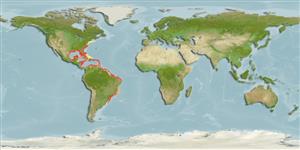Malacostraca |
Decapoda |
Portunidae
Environment: milieu / climate zone / depth range / distribution range
Ecology
Benthopelagic; depth range 0 - 393 m (Ref. 97531). Tropical; 41°N - 34°S, 98°W - 34°W
Western Atlantic. Temperate to tropical.
Length at first maturity / Size / Weight / Age
Maturity: Lm ? range ? - ? cm Max length : 9.2 cm CW male/unsexed; (Ref. 93549)
Carapace width range: 1.45 to 9.19 cm (Ref. 93549). Benthopelagic (Ref. 97531). Littoral (Ref. 106811). Associated with gravel and very coarse sand (Ref. 106810). Also on molluscan and other shells (Ref. 97531). In general, portunid crabs are reported to be mainly carnivorous (Ref. 72665).
Life cycle and mating behavior
Maturity | Reproduction | Spawning | Eggs | Fecundity | Larvae
Members of the order Decapoda are mostly gonochoric. Mating behavior: Precopulatory courtship ritual is common (through olfactory and tactile cues); usually indirect sperm transfer.
Bisby, F.A., M.A. Ruggiero, K.L. Wilson, M. Cachuela-Palacio, S.W. Kimani, Y.R. Roskov, A. Soulier-Perkins and J. van Hertum. 2005. (Ref. 19)
IUCN Red List Status (Ref. 130435)
CITES status (Ref. 108899)
Not Evaluated
Not Evaluated
Threat to humans
Human uses
| FishSource |
Tools
More information
Age/Size
Growth
Length-weight
Length-length
Morphology
Larvae
Abundance
Internet sources
Estimates based on models
Preferred temperature
(Ref.
115969): 17.2 - 26.8, mean 22.4 (based on 251 cells).
